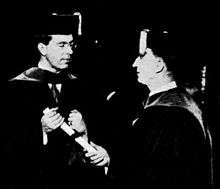Max Mason
Charles Max Mason (October 26, 1877 – March 22, 1961), better known as Max Mason, was an American mathematician. Mason was president of the University of Chicago (1925–1928) and president of the Rockefeller Foundation (1929–1936).[1][2]
Max Mason | |
|---|---|
 Max Mason | |
| Born | October 26, 1877 |
| Died | March 22, 1961 (aged 83) |
| Nationality | United States |
| Known for | differential equations calculus of variations electromagnetism |
| Scientific career | |
| Fields | mathematics |
| Institutions | University of Chicago Rockefeller Foundation |

Crown Prince Gustaf Adolf of Sweden receives his doctor's diploma as an honorary doctorate from the University of Chicago from the university's president, Professor Max Mason, 1926
Mason's mathematical research interests included differential equations, the calculus of variations, and electromagnetic theory.[3]
Education
- B.Litt., 1898, University of Wisconsin-Madison
- Ph.D., Mathematics, University of Göttingen, 1903.
- Dissertation: "Randwertaufgaben bei gewöhnlichen Differentialgleichungen" (Boundary value functions with ordinary differential equations)
- Advisor: Hilbert
Career
- Massachusetts Institute of Technology (MIT), 1903–1904, Instructor of Mathematics.
- Yale University, 1904–1908, Assistant Professor of Mathematics.
- University of Wisconsin–Madison, 1908–1909, University of Wisconsin–Madison, Associate Professor of Mathematics.
- University of Wisconsin–Madison, 1909–1925, Professor of Physics.
- National Research Council, 1917–1919, Submarine Committee. (Invented a submarine detection device, which was the basis for sonar detectors used in World War II.)
- University of Chicago, 1925–1928, President.
- Rockefeller Foundation, 1928–1929, Director, Natural Sciences Division.
- Rockefeller Foundation, 1929–1936, President.
- Palomar Observatory (California), 1936–1949, Chairman of the team directing the construction of the observatory.
On May 2, 1945 he appeared on Edgar Bergen's radio show to chat about the new observatory and trade jokes with Charlie McCarthy.[4]
Notes and references
- "Obituary: Max Mason". Physics Today. 14 (5): 78. May 1961. doi:10.1063/1.3057580. Archived from the original on 2013-09-21.
- Weaver, Warren. "mason-max.pdf" (PDF). NasOnline. Retrieved 13 September 2017.
- http://www-history.mcs.st-andrews.ac.uk/Biographies/Mason.html
- "Radio This Week", The Kansas City Star, April 25, 1948, p. 109. Newspapers.com (subscription needed), accessed 2014-04-20.
gollark: ||invisible||
gollark: abc
gollark: Okay. He can then go back.
gollark: 2. That's harassment.
gollark: @DaddySateen 1. You can.
External links
- Mathematicians: Charles Max Mason from the School of Mathematical and Computational Sciences, University of St. Andrews, Scotland
- Max Mason at the Mathematics Genealogy Project
- Max Mason from the University of Chicago
- Guide to the Max Mason Papers 1882-1961 at the University of Chicago Special Collections Research Center
- Guide to the University of Chicago Office of the President, Mason Administration Records 1910-1929 at the University of Chicago Special Collections Research Center
- National Academy of Sciences Biographical Memoir
| Academic offices | ||
|---|---|---|
| Preceded by Ernest DeWitt Burton |
President of the University of Chicago 1925–1928 |
Succeeded by Robert Maynard Hutchins |
This article is issued from Wikipedia. The text is licensed under Creative Commons - Attribution - Sharealike. Additional terms may apply for the media files.